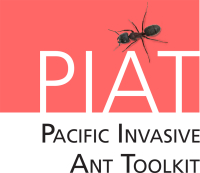Singapore ant
|
bites |
harms people |
harms wildlife |
lives in trees |
lives on ground |
night active |
day active |
different sizes |
|
Scientific name: Trichomyrmex destructor, until recently known as Monomorium destructor Other common names: destroyer ant; ninja ant; destructive trailing ant Size: 1.8-3.5 mm Colour: light yellow to dull brownish yellow with dark abdomen. General description: workers come in a large range of sizes (polymorphic). The body of this ant appears shiny and the abdomen is always darker in colour than the rest of the body. Habitat and nesting: the Singapore ant is a ground or tree dwelling species found in disturbed or modified habitats often near water. The ant may nest in wall and roof cavities in urban areas as well and is known to invade electrical sockets in houses. Outside, the ant may nest in pot plants and in standing trees including coconut plantations. Rate of spread: unknown. Distribution: see our invasive ant distributions page for the worldwide distribution of the Singapore ant. Reproduction: budding, but with potential for winged dispersal. For a detailed description of Singapore atns: PIAkey: Trichomyrmex destructor (see diagnostic characters tab) |
A close-up of a Singapore ant worker (© Eli Sarnat, Creative Commons Attribution, Share Alike CC BY-SA License)
Singapore ants foraging (© Eli Sarnat, Creative Commons Attribution, Share Alike CC BY-SA License) |
Social, agricultural and environmental impacts of the Singapore ant
This ant is a significant household pest in some places. It is known to infest houses, attack and bite people in bed and get into food products.
The Singapore ant can cause extensive economic damage, for example, it chews holes though fabric and rubber goods, removes rubber insulation from electric cables and phone lines, damages polyethylene cable, and shorts out car ignitions in vehicles parked in infested areas over night.
The ant may also carry human diseases.
It displaces other ant and invertebrate animals where it occurs.
|
Singapore ants foraging on peanut butter (© Eli Sarnat, Creative Commons Attribution, Share Alike CC BY-SA License) |
Video of Singapore ants foraging on peanut butter in Fiji, Vimeo video (© Eli Sarnat, Creative Commons Attribution, Share Alike CC BY-SA License) |
Information sources
AntWiki, Singapore ant
Biosecurity New Zealand Invasive Ant Threat Information Sheet number 10, Singapore ant
Global Invasive Species Database (GISD)
Global Register of Introduced and Invasive Species (GRIIS)
PIAkey, Singapore ant
Content reviewed by Eli Sarnat, Antwork Consulting, LLC, June 2017



